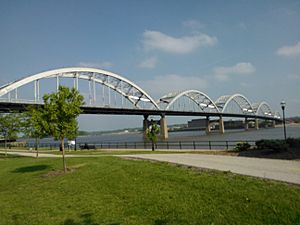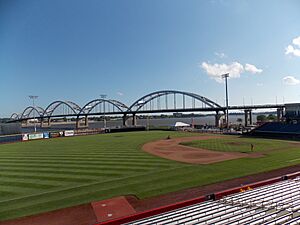Rock Island Centennial Bridge facts for kids
Quick facts for kids Centennial Bridge |
|
|---|---|
 |
|
| Coordinates | 41°30′54″N 90°34′54″W / 41.51500°N 90.58167°W |
| Carries | 4 lanes of |
| Crosses | Mississippi River |
| Locale | Davenport, Iowa and Rock Island, Illinois |
| Official name | Rock Island Centennial Bridge |
| Maintained by | Illinois Department of Transportation |
| Characteristics | |
| Design | Steel arch bridge Tied-arch bridge |
| Total length | 4,447 feet (1,355 m) |
| Longest span | 545 feet (166 m) |
| Clearance below | 66 feet (20 m) |
| History | |
| Opened | July 12, 1940 |
| Statistics | |
| Daily traffic | 14,900 |
The Centennial Bridge is a very important bridge that connects two cities: Rock Island, Illinois, and Davenport, Iowa. It crosses the mighty Mississippi River. This bridge is about 3,850 feet (1,173 m) long, which is almost three-quarters of a mile! It also stands tall, about 170 feet (52 m) above the water.
Contents
Building the Centennial Bridge
Work on the Centennial Bridge started in 1938. It took two years to build, and the bridge officially opened on July 12, 1940. Building it cost about $1.75 million, which was a lot of money back then!
- The bridge was designed by a group called Ash-Howard-Needles & Tammen.
- Several companies worked together to build it, including American Bridge Company.
Early Days and Tolls
When the bridge first opened, you had to pay a small fee, called a toll, to cross it. This was how the builders got their money back.
- At first, cars paid $0.10 to cross.
- Over time, the car toll went up to $0.50.
- Even people walking across the bridge had to pay $0.05 until 1960!
The tolls finally ended on May 2, 2003. A special event was held to celebrate the bridge becoming free to cross. The very first company to pay a toll in 1940, Dohrn Transfer Company, was also the last to pay when the tolls ended.

Lighting Up the Bridge
On September 4, 1988, something special happened: 128 bright lights were added to the arches of the bridge. These lights make the bridge look amazing at night! A group called River Action Inc. helped raise money for this lighting project.
New Ownership and Name
For many years, the city of Rock Island owned the bridge. But on July 13, 2005, the city gave ownership to the Illinois Department of Transportation. This happened after more than $11 million was spent to make important upgrades to the bridge's structure.
The bridge was almost named the "Galbraith Bridge" after Rock Island's mayor, Robert Galbraith. But he suggested it be called the "Centennial Bridge" instead. This name celebrated Rock Island's 100th birthday (its centennial). In 2017, the bridge got another official name: the Master Sgt. Stanley Talbot Memorial Bridge, honoring a brave soldier.
A Symbol for the Quad Cities
The Centennial Bridge has five large arches, and these arches have become a special symbol for the Quad Cities area.
- The two biggest arches represent the cities of Rock Island and Davenport.
- The three smaller arches stand for the other nearby cities: Bettendorf, Moline, and East Moline.
The bridge is located near some fun places. On the Davenport side, Modern Woodmen Park (where a baseball team plays) is just upstream. On the Rock Island side, a lively area called "The District" is only a block away.

